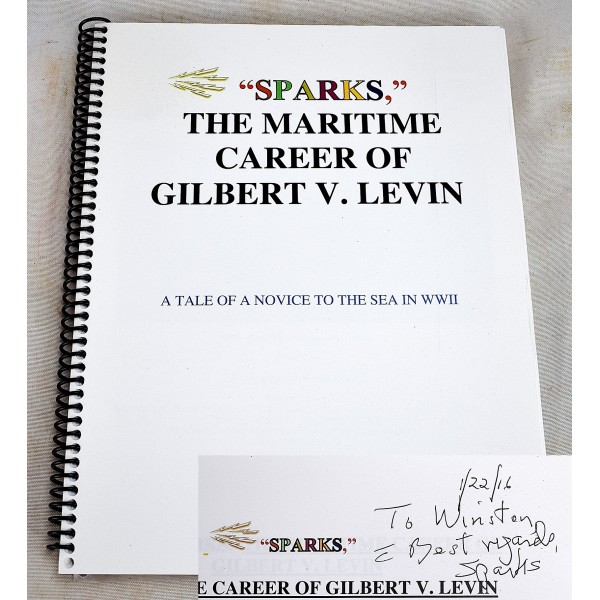Sparks: The Maritime Career of Gilbert V. Levin
Sparks: The Maritime Career of Gilbert V. Levin
Gilbert V. Levin
Self Published, 2016
Includes a note inscribed by Gilbert V. Levin. Inscribed on title page. Softcover. Plastic Comb binding. Good binding and cover. Minor shelf wear. Clean, unmarked pages. *Autographed by author.*
A tale of a novice to the sea, details Levin's time as a radio operator during World War II.
Gilbert V. Levin, whose experiment on NASA's Viking mission in the 1970s seemed to suggest that there might be life in the soil of Mars. Most planetary scientists dismissed Dr. Levin's conclusions. But he remained steadfast that his experiment had operated as designed, and that no one could offer a plausible alternative explanation. Over the years, scientific opinion has become more receptive to the possibility that life could have arisen on Mars and may even persist there today. Half a century ago, the notion of sequencing the genomes of living organisms was a fanciful impossibility, so Dr. Levin and another investigator, Patricia A. Straat, proposed a clever way to test whether the soil of Mars contained any microbes. NASA agreed to fly their apparatus on the two Viking spacecraft, which were launched in 1975 and which both successfully landed on Mars the next year. In their experiment, food for microbes was added to samples of Martian soil, and the organic molecules in the food contained unstable carbon-14 atoms. The idea was that if microbes digested the food, they would produce easily detectable radioactive carbon dioxide that would rise out of the soil. Dr. Levin called it the labeled release experiment, because the carbon dioxide had been labeled by the carbon-14 atoms. That is exactly what happened at both Viking landing sites, 4,000 miles apart. Other samples were then heated to 320 degrees Fahrenheit to sterilize them. If microbes were generating the radioactive gases, there should have been no gas rising from the sterilized soil. But after an initial flurry of excitement, the consensus among scientists was that Mars was lifeless, and that therefore there had to be some other explanation for Dr. Levin's results. The images of the Martian landscape were desolate. More crucially, another experiment measured a complete lack of organic molecules, the carbon-based building blocks of life. Over the decades, the pendulum has swung the other way; it is now believed that Mars was once warm and wet and potentially habitable. Some scientists think microbial life could still be hanging on, although most likely deep underground, where it would be protected from frigid temperatures and barrages of radiation. In addition, a discovery by a later NASA mission to Mars offered possible evidence that Dr. Levin could have been right after all. In 2008, NASA's Phoenix lander found chemicals known as perchlorates in the Martian soil. Viking's organic molecule detector had heated the soil to release organics. But heating organic molecules in the presence of perchlorates destroys them, so even if they were there, Viking's experiment might have missed them.





